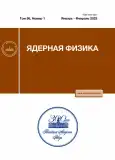Fractal Analysis of Monte Carlo AuAu Events at GeV
- Autores: Dedovich T.G.1,2, Tokarev M.V.1,2
-
Afiliações:
- Joint Institute for Nuclear Research
- Dubna State University
- Edição: Volume 86, Nº 1 (2023)
- Páginas: 276-284
- Seção: МАТЕРИАЛЫ LXXII МЕЖДУНАРОДНОЙ КОНФЕРЕНЦИИ “ЯДРО-2022: ФУНДАМЕНТАЛЬНЫЕ ВОПРОСЫ И ПРИЛОЖЕНИЯ”. Элементарные частицы и поля. Теория
- URL: https://journals.rcsi.science/0044-0027/article/view/139684
- DOI: https://doi.org/10.31857/S0044002723010154
- EDN: https://elibrary.ru/RBASAL
- ID: 139684
Citar
Texto integral
Resumo
The results of a fractal analysis of Monte Carlo AuAu events at the c.m. collision energy of
GeV on the basis of the method of the System of Equations of P-basic Coverage (SePaC) are presented. A MultiPhase Transport (AMPT) model is used to generate collision events. The transverse momentum
of negatively charged particles detected in the pseudorapidity range of
in events of different centrality between (0–5)
and (30–40)
is considered as the variable under study. Sets of random events and Monte Carlo fractals are compared. The difference in the behavior of the dependence of the fraction of events reconstructed as fractals on the parameters of the method for different types of data are demonstrated. Optimum values of the parameters for an analysis of AMPT AuAu events are found. It is indicated that the portion of Prtn events reconstructed as fractals depend on the centrality and multiplicity in AuAu and random events, respectively. Insignificant distinctions in the behavior of the distributions with respect to dimension for different centrality classes are found. Two event classes differing in the shape of transverse-moment spectra are singled out among AMPT AuAu events.
Sobre autores
T. Dedovich
Joint Institute for Nuclear Research; Dubna State University
Email: tdedovich@yandex.ru
141980, Dubna, Russia; 141980, Dubna, Russia
M. Tokarev
Joint Institute for Nuclear Research; Dubna State University
Autor responsável pela correspondência
Email: tokarev@jinr.ru
141980, Dubna, Russia; 141980, Dubna, Russia
Bibliografia
- E. Akkermans, G. V. Dunne, and A. Teplyaev, Phys. Rev. Lett. 105, 230407 (2010).
- D. G. Moore and V. H. Satheeshkumar, Phys. Rev. D 90, 024075 (2014).
- P. V. Buividovich, T. Kalaydzhyan, and M. I. Poli- karpov, Phys. Rev. D 86, 074511 (2012).
- M. K. Ghosh, P. K. Haldar, S. K. Manna, A. Mukho- padhyay, and G. Singh, DAE Symp. Nucl. Phys. 54, 590 (2009).
- A. Deppman, Phys. Rev. D 93, 054001 (2016).
- N. G. Antoniou, N. Davis, and F. K. Diakonos, Phys. Rev. C 93, 014908 (2016).
- I. Zh. Bunzarov, N. Y. Chankova-Bunzarova, and O. V. Rogachevsky, Phys. Part. Nucl. Lett. 11, 404 (2014).
- J. D. Bjorken, Phys. Rev. D 45, 4077 (1992).
- Z.-W. Lin and C. M. Ko, Phys. Rev. C 65, 034904 (2002).
- Z.-W. Lin, C. M. Ko, B.-A. Li, B. Zhang, and S. Pal, Phys. Rev. C 72, 064901 (2005).
- T. G. Dedovich and M. V. Tokarev, Phys. Part. Nucl. Lett. 10, 481 (2013).
- T. G. Dedovich and M. V. Tokarev, Phys. Part. Nucl. Lett. 10, 491 (2013).
- T. G. Dedovich and M. V. Tokarev, Phys. Part. Nucl. Lett. 13, 169 (2016).
- T. G. Dedovich and M. V. Tokarev, Phys. Part. Nucl. Lett. 9, 552 (2012).
- T. G. Dedovich and M. V. Tokarev, Phys. Part. Nucl. Lett. 13, 178 (2016).
- T. G. Dedovich and M. V. Tokarev, Phys. Part. Nucl. Lett. 14, 865 (2017).
- T. G. Dedovich and M. V. Tokarev, Phys. Part. Nucl. Lett. 16, 240 (2019).
- T. G. Dedovich and M. V. Tokarev, Phys. Part. Nucl. Lett. 18, 93 (2021).
- F. Hausdorff, Math. Ann. 79, 157 (1918).
Arquivos suplementares









